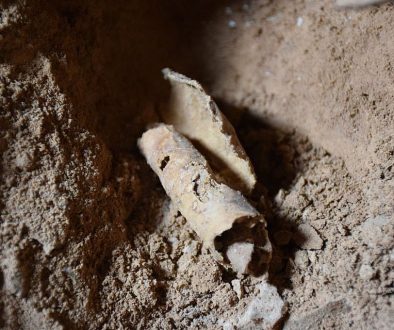Egyptian Sea Vessel Artifacts Discovered At Pharaonic Port Of Mersa Gawasis Along Red Sea Coast
Boston — When Kathryn Bard reached through the small hole that opened in a hillside along Egypt’s Red Sea coast, her hand touched nearly 4,000 years of history.
The opening that Bard, an associate professor of archaeology at Boston University, and her team’s co-leader Rodolfo Fattovich, a professor of archaeology at Italy’s University of Naples “L’Orientale,” discovered was the entrance to a large, man-made cave. Two days later at a site about 30 meters beyond this cave, the team removed sand covering the entrance to a second cave, one that held the well-preserved cedar timbers of an ancient Egyptian sea-faring vessel.
The timbers, together with limestone block-anchors, curved cedar steering oars, rigging ropes, and other items, are from ancient Egyptian ships. In addition to the nautical items in the second cave, and the two antechambers discovered to branch from it, the archaeologists found limestone tablets with hieroglyphic inscriptions that detail long-ago trade expeditions to the Red Sea region known as Punt.
Bard and Fattovich will present their findings on the two caves — and discuss the promise their discoveries hold — to fellow archaeologists on April 23 during the 56th annual meeting of the American Research Center in Egypt (ARCE) in Cambridge, Mass.
Bard and Fattovich and their team made the dual discovery in late December while working at Wadi Gawasis, the site of the pharaonic port of Mersa Gawasis on the Red Sea coast of Egypt. The cave they unearthed not only contained artifacts that spoke of ancient Egypt’s sea-faring vessels, it also had been constructed from recycled items from such vessels. Limestone anchor blocks and cedar beams from a ship, along with mud-brick and plaster, had been used to stabilize the walls forming the cave’s entrance.
Inside the entrance were the two cedar steering oars found by the group. The scientists speculate that the oars may have been used on 70-foot-long ships from a 15th -century naval expedition launched by Egypt’s Queen Hatshepsut to the southern Red Sea trade center, Punt. Well-preserved and intact, the oars are the first complete parts from a sea-faring ship to have been found in Egypt. Near the oars were found pieces of pottery dating from 1500 – 1400 B.C.
The cave also held hints of use as a temple. Near its entrance, the research team found small carved niches, four of which still held limestone tablets, known as stelae. One stela, the best preserved, bore hieroglyphic inscriptions describing expeditions to Punt and to Bia-Punt, the location of which is unknown. It also told of two officials, Nebsu and Amenhotep, who led the expeditions. Other inscriptions on the stela include an offering scene to the god Min, the god of the Eastern Desert also associated with fertility, and a cartouche of King Amenemhat III, who ruled Egypt around 1800 B.C. The stela’s text provides new information about King Amenemhat III, suggesting he ordered the previously unknown expeditions to the Punt and Bia-Punt regions.
The team of archaeologists plans to return to the excavation site at year’s end, this time with a researcher who will use ground-penetrating radar to determine if there are additional caves in the area and, if so, what their configurations are.
Editor’s Note: The original news release can be found here.





